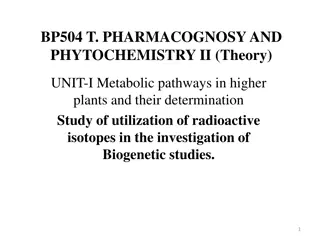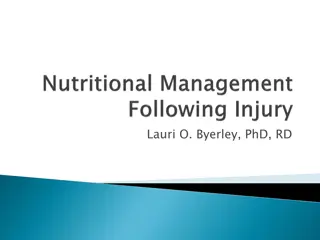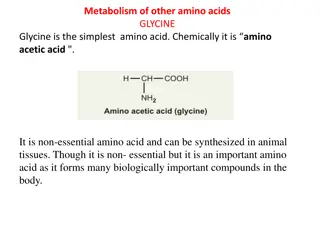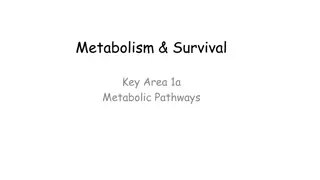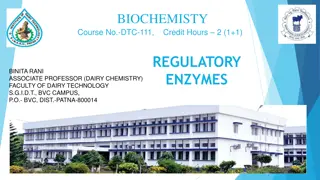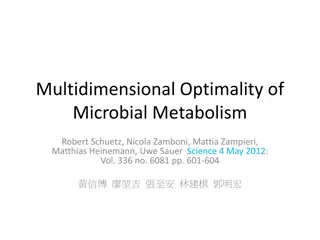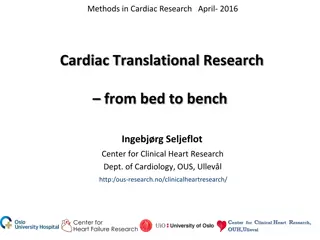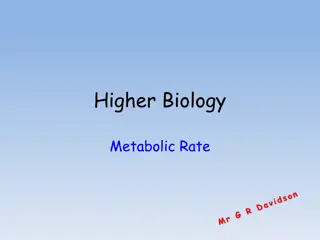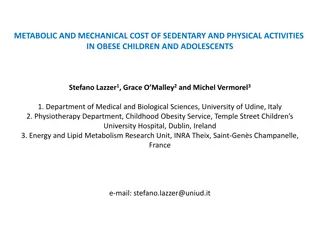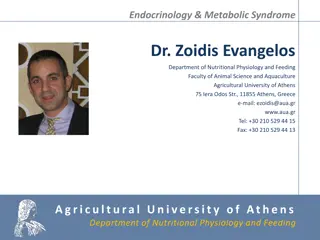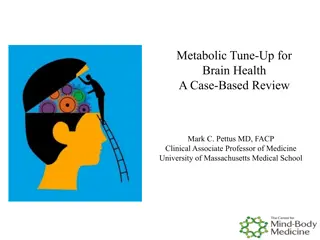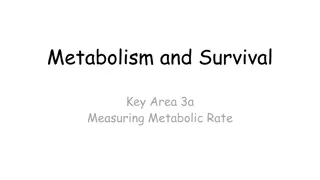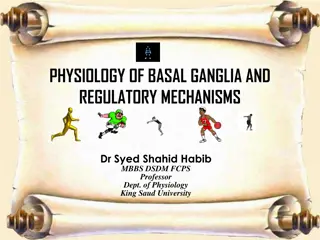Understanding Metabolic Pathways and Regulatory Mechanisms
Metabolic pathways are a series of enzymatic reactions interconnected to form a flow of substrates and products. Irreversible steps, known as committed steps, determine pathway direction. Regulation, through positive or negative feedback, controls enzyme activity. Branched pathways share common intermediates. Coenzymes, isozymes, ATP, and redox reactions play critical roles in energy transfer and reaction coupling in metabolism.
Download Presentation

Please find below an Image/Link to download the presentation.
The content on the website is provided AS IS for your information and personal use only. It may not be sold, licensed, or shared on other websites without obtaining consent from the author. Download presentation by click this link. If you encounter any issues during the download, it is possible that the publisher has removed the file from their server.
E N D
Presentation Transcript
Learning Objectives Be able to describe a the key properties of a metabolic pathway. Be able to describe the various modes of regulation of metabolic pathways as they are presented in this lecture. Be able to explain the key properties of coenzymes, and know the types of group carried by each coenzyme discussed in this lecture. Be able to explain what isozymes are and why they are important in medicine. Be able to describe the important characteristics of anabolic pathways and catabolic pathways. Be able to explain why ATP is called the energy currency of the cell, why phosphoanhydride bonds are "high energy" bonds, and what the term substrate-level phosphorylation means. Know the molecules discussed in this lecture that can transfer phosphate groups to ADP or receive phosphate groups from ATP. Understand what is meant by the term "coupled reaction" and the role of ATP hydrolysis and redox reactions in reaction coupling. Be able to explain in broad terms how reduced electron carriers are used to generate ATP via the electron transport system in mitochondria. Understand the role of thioesters and acetyl-CoA in metabolism. Be able to describe the reactions catalyzed by kinases, phosphatases, dehydrogenases, synthases/synthetases, transferase, and isomerases.
Metabolic Pathways: What Are They and What Do They Look Like? A metabolic pathway is a series of enzymatic reactions that are interconnected so that the product of one reaction becomes the substrate for the next reaction in the pathway. A C D E B Enzyme 1 Enzyme 2 Enzyme 3 Enzyme 4 Reactions that are reversible are indicated by arrows between substrate and product pointing toward both the beginning and the end of the pathway. Irreversible reactions are indicated by an arrow pointing in only one direction. An irreversible reaction is usually associated with a large change in free energy (Gibbs free energy = G is large and negative).
Metabolic Pathways: What Are They and What Do They Look Like? committed step A Enzyme 1 C D E B Enzyme 2 Enzyme 3 Enzyme 4 The first irreversible step in a metabolic pathway is called the committed step. Once a reactant has passed through this step, the reactant is committed to flow down the pathway.
Metabolic Pathways: What Are They and What Do They Look Like? committed step A Enzyme 1 C D E B Enzyme 2 Enzyme 3 Enzyme 4 The activity of the enzyme catalyzing the committed step is often regulated. Regulation can be either positive (increases activity of the enzyme and of flow through the pathway) or negative (decreases activity of the enzyme and of flow through the pathway). Most often a product further down the pathway binds to a regulatory site on the enzyme and inhibits the enzyme s activity by causing a change in the shape of the enzyme. This is termed allosteric regulation.
Metabolic Pathways Can Be Branched, Allowing Use of a Common Intermediate for Several Pathways In branched pathways, an intermediate in one pathway can enter multiple pathways leading to different final products. In this example, the amount of compound C flowing into each branch depends upon the relative amount and activity of enzymes E3 and E5.
Metabolic Pathways Can Be Branched, Allowing Use of a Common Intermediate for Several Pathways The activity of each branch is controlled by feedback inhibition in which the final product of each branch inhibits the enzyme catalyzing the first committed step of that branch. The activity of E2is also regulated so that in the event that C builds up, the activity of E2 can be decreased.
Enzymes in Metabolic Pathways Can Also Be Positively Regulated + Stimulation of E2will increase production of C and therefore flow will increase down both branches. Stimulation of E3 by an end product of the opposite branch can help keep flow through the to branches balanced.
Regulation of Enzymes in Metabolic Pathways Can Occur at Multiple Levels At the cellular level, enzyme activity can be controlled by: o the availability of substrate or by the amount of product o the availability of coenzymes and cofactors o changes in transcription of the gene encoding the enzymes, in translation of the mRNA, and in the rate of degradation of the enzyme o the binding of small molecules at sites other than the active site = allosteric regulation At the whole body level, enzyme activity is often regulated in response to changes in levels of hormones.
Coenzymes Coenzymes are complex nonprotein organic molecules that participate in enzymatic catalysis by providing functional groups essential to catalysis. Each coenzyme is specific for a specific group of related enzymes that catalyze similar types of reactions. In general, coenzymes can be of two types: activation transfer coenzymes (activate and carry groups as they are transferred from substrate and product) and oxidation- reduction coenzymes (carry electrons between substrate and product). Many coenzymes are derived from vitamins. Symptoms of vitamin deficiencies reflect the loss of specific enzyme activities that require the coenzyme. Examples of Coenzymes Mentioned in this Lecture Carrier Molecule Group Carried in Activated Form Vitamin Source of Coenzyme ATP Phosphoryl NADH and NADPH Electrons Niacin FADH2 Electrons Riboflavin Coenzyme A Acyl Pantothenate
Coenzyme A Activates Acyl Groups for Further Metabolism Although they do not contain a phosphate group, thioesters also releases a large amount of energy upon hydrolysis. In cells, acetyl- and acyl groups generated during metabolism are eventually oxidized via the Citric Acid (Krebs) Cycle. These groups are carried as thiol esters linked to Coenzyme A. Hydrolysis of the thioester bond linking the acetyl/acyl group to Coenzyme A releases a large amount of energy, making reactions involving acetyl-CoA hydrolysis essentially irreversible.
Enzyme Names and What They Tell You The names of enzymes often tell you the kind of reaction carried out by an enzyme and the name of a substrate the enzyme acts upon. This can be invaluable for your learning of key reactions in metabolism. The list below is not exhaustive but contains many of the key classes of enzymes you will encounter in your studies. Kinases - catalyze the phosphorylation of a metabolite or a protein, most often using ATP as donor of the phosphate. Phosphorylations often activate compounds. Phosphatases - catalyze hydrolytic removal of a phosphate group from a metabolite or a protein (also called dephosphorylation.) Dehydrogenases -catalyze redox reactions, generally using NAD+/NADH or FAD/FADH2. Synthase or synthetase - catalyzes the joining of two molecules to make a larger molecule. Transferase - transfer of a functional group from one molecule to another. Examples include transaminases (transfer amine groups) and phosphotransferases (transfer phosphate groups). Isomerase - converts one isomer to another.
Isozymes Allow Similar Reactions to Be Differentially Regulated in Different Cell Types or Tissues Isozymes are enzymes that catalyze the same reaction but differ in amino acid sequence, and sometimes in structure. Isozymes of an enzyme are encoded by different (but often related) genes. The importance of isozymes lies in the fact that their kinetic parameters and regulation often differ. The particular isozyme expressed in a specific tissue is the one that is the best fit in regulatory properties and activity to the needs of that tissue. Differences in tissue expression mean that isozymes can be used as specific markers of cellular damage. Example: the 5 isozymes of lactate dehydrogenase (LDH) are concentrated in different tissues. Routinely used in the differentiation of myocardial infarction, liver disease and erythrocyte damage. In some cases cancer cells express isozymes that are not normally found in well- differentiated cells; one focus of cancer therapeutics research is use this to identify drugs that target these enzymes specifically, thereby killing cancer cells but not normal cells.
Cellular Energetics The primary dietary fuels used by the human body are carbohydrates, fats, and to a lesser extent, proteins. Breakdown of these fuels (catabolism) releases energy as chemical bonds are broken. Some of this energy is captured in either of two forms: phosphoanhydride (ADP ATP), or reducing equivalents (NAD+ NADH, NADP+ NADPH , or FAD+ FADH2). bonds
Overview of Cellular Energetics The primary dietary fuels used by the human body are carbohydrates, fats, and to a lesser extent, proteins. Breakdown of these fuels (catabolism) releases energy as chemical bonds are broken. Some of this energy is captured in either of two forms: phosphoanhydride bonds (ADP ATP), or reducing equivalents (NAD+ NADH, NADP+ NADPH, or FAD+ FADH2). NADH and FADH2 can be used to generate ATP via the electron transport chain. ATP, NADPH and FADH2 are used in anabolic reactions to synthesize complex molecules from simpler precursor molecules. In these reactions ATP ADP, NADPH NADP+, and FADH2 FAD+.
Cellular Energetics: What is Special About ATP? phosphoanhydride bonds ] ATP contains 2 phosphoanhydride bonds. ] Each phosphoanhydride bond is a highenergy bond in that a large amount of free energy is released when the bond is broken. ATP G = -7.3 kcal/mol When the phosphoanydride bond is broken, 7.3 kcal/mol of energy is released and can be used for cellular work. ADP
Cellular Energetics: ATP Can Be Made Via Transfer of Phosphate Groups Down a Free Energy Gradient Some phosphate-containing compounds release more than 7.3 kcal/mol upon phosphate hydrolysis; these groups can transfer a phosphate to ADP to make ATP. Free Energy of Hydrolysis of Some Phosphorylated Compounds Go (kcal/mol) Compound Similarly, ATP can transfer phosphate to molecules with less negative G0 ; some of the energy in the newly-formed bond activates the molecule for additional reaction. Phosphoenol pyruvate -14.0 Phosphocreatine -10.3 Energy Free ATP (to ADP) -7.3 Glucose 1-phosphate -5.0 Glucose 6-phosphate -3.3 Glycerol 3-phosphate -2.2 These phosphate transfer reactions are one reason that ATP is called the energy currency of the cell. The transfer reactions are enzyme-catalyzed and are called substrate level phosphorylation reactions.
Cellular Energetics: Coupled Reactions - 1 In coupled reactions, energy released in one reaction is transferred to the components of an energy requiring reaction. Coupled reactions allow energetically unfavorable reactions to proceed. In living organisms, reactions are usually coupled in one of two ways. 1. ATP hydrolysis - Free energy liberated by ATP hydrolysis is harnessed to drive a second, energetically unfavorable reaction. The energy liberated by ATP hydrolysis must exceed the energy required for the second reaction for coupling to be successful. Usually coupling is achieved by having the same enzyme catalyze ATP hydrolysis and the energetically unfavorable enzyme. This type of coupled reaction is written as:
Cellular Energetics: Coupled Reactions - 2 2. Oxidation-Reduction (Redox) reactions - In redox reactions, a reduced (electron rich) molecule transfers electrons to an oxidized (electron poor) molecule. In the process the electron donor becomes oxidized and the electron recipient becomes reduced. This is a coupled reaction because oxidation of one molecule cannot happen without reduction of another molecule and because the energy (in the form of electrons) will eventually be used to do chemical work. Special electron carrier molecules (NAD = nicotine adenine dinucleotide, and FAD = flavin adenine dinucleotide, both derived from vitamins) are usually used in biological redox reactions. NAD+ NADH + H+ Reduced Substrate Oxidized Product (lost electrons relative to substrate) Or FAD FADH2 Reduced Substrate Oxidized Product (lost electrons relative to substrate)
In Aerobic Animals, Most ATP Is Produced Using Reducing Equivalents and An O2-dependent Electron Transport Chain NAD:H and FAD:H2 transfer their electrons to the electron transport chain (ETC) in mitochondria. The electrons provide the energy used to pump protons across the membrane to create a proton gradient. Ultimately the electrons are used to reduce O2 to H2O. O2 is absolutely essential to keep the system going. The proton gradient drives ATP synthesis (using ADP and inorganic phosphate) by ATP synthase. Each NADH that enters the electron transport chain produces 2.5 ATP while each FADH2 produces 1.5 ATP. Note that as electrons are transferred from one protein to another, pumped out. The proton gradient conformational change in ATP synthase that leads to ATP production. protons are drives a




